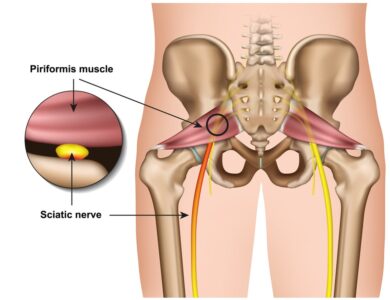- 02 9712 1736
- [email protected]
- 212 Great North Road, Five Dock, NSW 2046
- Open 6 days from 7am
Sciatic pain, commonly referred to as sciatica, is a broad term for nerve pain arising from pressure at any one point on the entire length of the sciatic nerve. Pain is often felt along the nerve pathway from the lower back, buttock, back of thigh, and calf. Pain can vary from a mild ache to a sharp, burning pain. In some cases, there may be tingling, numbness, and muscle weakness in the affected leg.
The sciatic nerve is a large nerve formed by several nerve roots that emerge off the spinal cord that join up after passing between the disc spaces in the spine to make a single nerve. The sciatic nerve then travels into the buttock, the back of the thigh, and the lower leg. The sciatic nerve provides sensation and function in the leg and foot. It controls the muscles in the back of the thigh, the lower leg, and the foot. It also provides sensation to the skin on the back of the thigh, the outer side of the lower leg, and the sole of the foot, as such compression or irritation of the sciatic nerve results in symptoms being felt in these areas.


Disc Herniation
Spinal Stenosis
Spinal stenosis is another potential cause of sciatica. It occurs when there is narrowing in the spinal canal which contains the spinal cord or the intervertebral spaces where the nerve roots exit, which puts pressure on the nerve roots that exit the spine, in this case those that form the sciatic nerve. The narrowing of the spinal canal and/or intervertebral spaces can be caused by a variety of factors, including herniated discs, bone spurs, thickened ligaments, and spinal tumors.
Spondylolisthesis is a condition that occurs when one vertebra in the spine slips out of its normal position and onto the vertebra below it. This can cause compression of the nerve roots that exit the spine, including those that form the sciatic nerve.
Spondylolisthesis is most commonly caused by degenerative changes in the spine that occur with aging, such as arthritis or disc degeneration. It can also be caused by trauma, such as a fracture or dislocation of the spine. The degree of slippage and location of the affected vertebra will determine the severity and location of the symptoms.
Piriformis syndrome is a condition that occurs when the piriformis muscle, a small muscle located in the buttocks, compresses the sciatic nerve. The piriformis muscle runs from the sacrum (the triangular bone at the base of the spine) to the hip joint and helps to rotate the hip and thigh outward.
When the piriformis muscle becomes tight or inflamed, it can pressure the sciatic nerve, leading to sciatica symptoms. Piriformis syndrome can be caused by overuse, injury, or sitting for long periods.
Pregnancy
Sciatica can be a common problem during pregnancy due to changes in a woman’s body during this time. For example, the growing uterus and the weight gain associated with pregnancy can pressure the sciatic nerve, leading to sciatica symptoms.
In addition, the hormonal changes that occur during pregnancy can cause the ligaments in the pelvis to relax and become more flexible, which can also put pressure on the sciatic nerve.

Acute Sciatic Nerve Pain Treatment
Many clinics won’t treat acute sciatica pain at all, but we treat plenty of it. The key is to improve your mobility when you are in lots of pain. We do this by doing your treatment both standing and lying down, as only lying down would aggravate your pain. If you have improved movement early you can quickly resolve your pain.
Chronic Sciatic Nerve Pain Treatment
Chronic sciatic nerve pain causes a change in your brain (alteration of the sensory processing of the brain leading to amplification of pain). About 20% of people affected by acute sciatic nerve pain develop chronic lower back and leg pain. Five Dock Osteopathic and Chiropractic has found that the key to fixing chronic pain is to retrain your sensorimotor system so it no longer amplifies pain. This is done with targeted massage, adjustments and very specific exercises.
Sciatic Nerve Pain Treatment Methods
We have a number of special methods for treating all kinds of lower back pain:
We have our own unique style of massage developed to complement our adjustments. We are experts at tracing the cause of sciatic pain to its source, and our treatment includes both the front of the body (hip and thigh muscles) and back (lumbar spine, hip and hamstring muscles). This approach focuses on you as a whole person, not just a part in isolation, and so it brings you not only short-term relief from pain, but also lasting improvements to your health and well-being. Our adjustments all use traction making them smooth and gentle on your body. We will then work with you to devise personalised functional exercises that you can use to strengthen your core and postural muscles to build your stability.

About
Five Dock Osteopathic & Chiropractic is located in Canada Bay, in Sydney’s Inner West. Servicing suburbs including Burwood, Croydon, Drummoyne, Five Dock, Haberfield, Concord, Abbotsford, Chiswick, Leichhardt, Wareemba, Russell Lea, Summer Hill, Strathfield.
Clinic hours
Monday, Tuesday, Thursday 7AM – 7PM
Wednesday, Friday 7AM – 5PM
Saturday 7AM – 2PM
Sunday Closed
Contact details
212 Great North Road, Five Dock, NSW 2046
Phone: 02 9712 1736
Fax : 02 9712 1736
Email : [email protected]